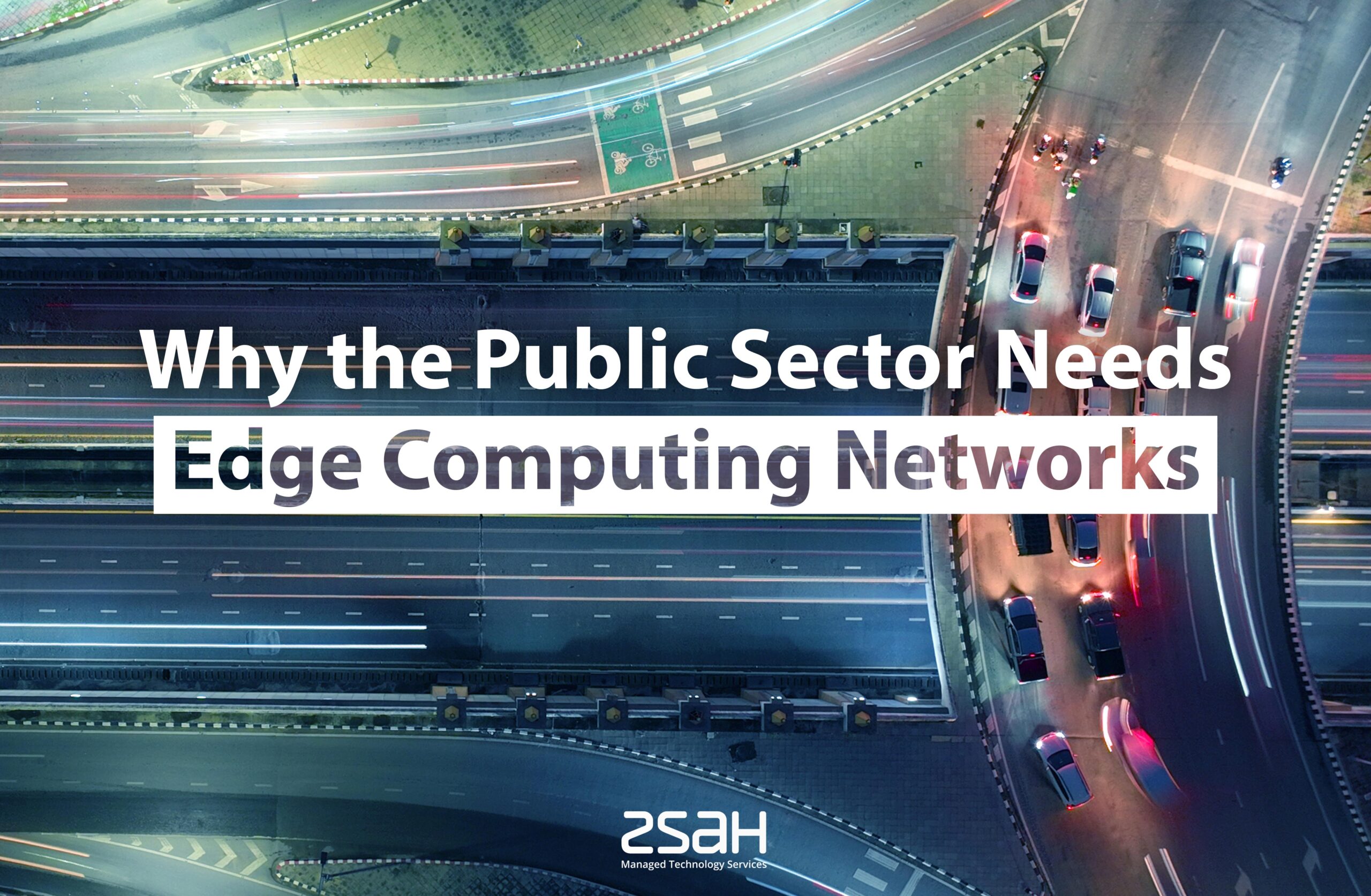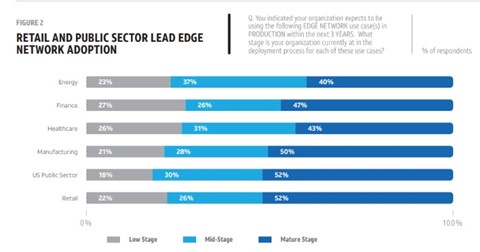Why the Public Sector Needs Edge Computing Networks

Edge computing networks are increasingly essential to public sector operations. By optimising data generated from public sector activities and interactions for quick access at the point of need, this technology improves service delivery, security, and cost-effectiveness. It enables agencies to make better decisions more quickly, such as finding smart solutions to safety situations or adjusting public transportation according to changing conditions. It also aids agencies in managing public services more economically and responsively.
Public sector institutions are leading the way in adopting edge networks in various locations around the world. For example, according to the AT&T Cybersecurity Insights Report, the US public sector is the most mature of all sectors surveyed – 52% of public institutions are at an advanced stage of implementation, while 30% of are mid-stage.
(Image source: Att.com)
Below are a few examples of how edge computing is being used in the public sector.
Edge Computing in Transportation
Edge computing is revolutionising public sector transportation, enabling public agencies to collect and process huge data volumes. Data can be collected from a myriad of sources such as onboard GPS systems, traffic signals, bus stops, bridges, roadways, and rail stations. The technology then allows public agencies to analyse this data quickly and precisely to optimise public resources for maximum safety and efficiency, and make better decisions that benefit citizens. In short, edge computing gives public sector transportation an unprecedented level of insight into how best to serve the public's needs and the ability to respond to this in real-time.
Edge Computing in Smart City Management
Edge Computing is being used in Smart City Management to make cities more efficient and better serve their citizens. For example, edge computing provides data insights on traffic patterns, enabling real-time adjustments to traffic control systems and reducing congestion. Emerging technologies such as the Internet of Things (IoT) are being harnessed to measure air quality levels in local neighbourhoods and advise public health organisations accordingly. Edge computing is also helping optimise energy usage, helping cities move towards renewable sources like solar and wind power.
Furthermore, this technology enables smart city governments to design integrated services for citizen engagement. Integrating multiple services enables citizens to access information from a single source through modern interfaces like mobile applications or voice assistants. The aim is to create smart cities that respond quickly and effectively to the changing needs of the public.
Edge Computing in Defence
By setting up many distributed computing nodes with edge node software, the military can slash data latency to near-zero levels, allowing for mission-critical updates to be sent in real time while eliminating much of the potential risk of public broadcasting.
In addition, edge computing adds an extra layer of security as any hostile probing is met with a faster response than possible through a traditional public cloud setup. This provides huge advantages when dealing with legacy defence systems that need high-speed responses and tight security.
Edge Computing in Law Enforcement
The public sector is increasingly embracing this technology in law enforcement. Edge computing's ability to process large amounts of data in real time makes it ideal for crime fighting, allowing law enforcement agencies to analyse and act on threat information as soon as it is received.
It also helps reduce costs by giving police agencies more capabilities with fewer resources, allowing them to focus on the most essential functions without worrying about whether they have enough labour and budget. For example, many police departments are using body-worn cameras to collect video footage on public streets, which can then be analysed and acted upon through edge computing networks. In addition, many cities are now using footage from drones to improve public safety and catch criminals.
Edge Computing in Emergency Response
The revolutionary technology has started to revolutionise public sector emergency response efforts around the world. By allowing streaming data to be quickly analysed at the edge of a network in real time, public safety leaders can significantly improve their understanding and responses to events when they happen. The ability to instantly receive and process incoming data gives public sector responders an added insight into the underlying dynamics of an emergent crisis, allowing them to make informed decisions more quickly and act swiftly with precision.
This technology promises to revolutionise public sector emergency response, giving public safety officials the necessary advantage while responding to challenging situations.
Edge Computing in Education
Edge computing is emerging as a powerful technology to address the public sector's need for increased flexibility, computing resources, and cost efficiencies when addressing educational mandates. By decentralising computing power and storage at the network's edge, public organisations can empower students and researchers with near-real-time data while providing secure access to critical digital resources.
Furthermore, it helps universities cost-effectively scale up or down their IT capabilities to meet specific mission requirements, such as providing secure online classrooms or high-performance analytics research labs. Additionally, cultivating edge capabilities can help public sector institutions gain greater insights from their data systems more quickly and securely.
In sum, public agencies are turning to this technology to fulfil higher education institutions' educational mandates more efficiently.
Edge Computing in Energy
The public sector is also investing in edge solutions to address the challenges of the energy industry. Edge computing and other distributed computing models can help address the massive data volumes and demands that come with smart grid implementations, as well as their inherent security risks. Edge nodes can be placed around critical infrastructure points, including electrical substations and power plants, helping to improve the performance and reliability of energy systems. Edge-based data management platforms can also ensure that critical data is securely stored and processed, reducing the risk of cyberattacks or other threats to energy systems in the public sector.
Sign Up Now!
For expert advice and resources – blogs, interviews, webinars, guides and more.
How zsah Managed Edge Computing Service Can Help
As an established leader in edge computing solutions, zsah is well-equipped to help public sector organisations take full advantage of this transformative technology. Our highly scalable and flexible service models allow our clients to easily deploy and manage edge resources at their network's edge, reducing costs while improving efficiency and security.
Additionally, our extensive expertise in managing mission-critical data and applications gives our clients access to the insights they need to make smart decisions and stay ahead of emerging trends in the digital age. Whether you are looking to improve public transport, emergency response efforts, empower students, or enhance energy systems, zsah is here to help your organisation take full advantage of edge computing networks and realise its full potential. For more information, contact us today.


